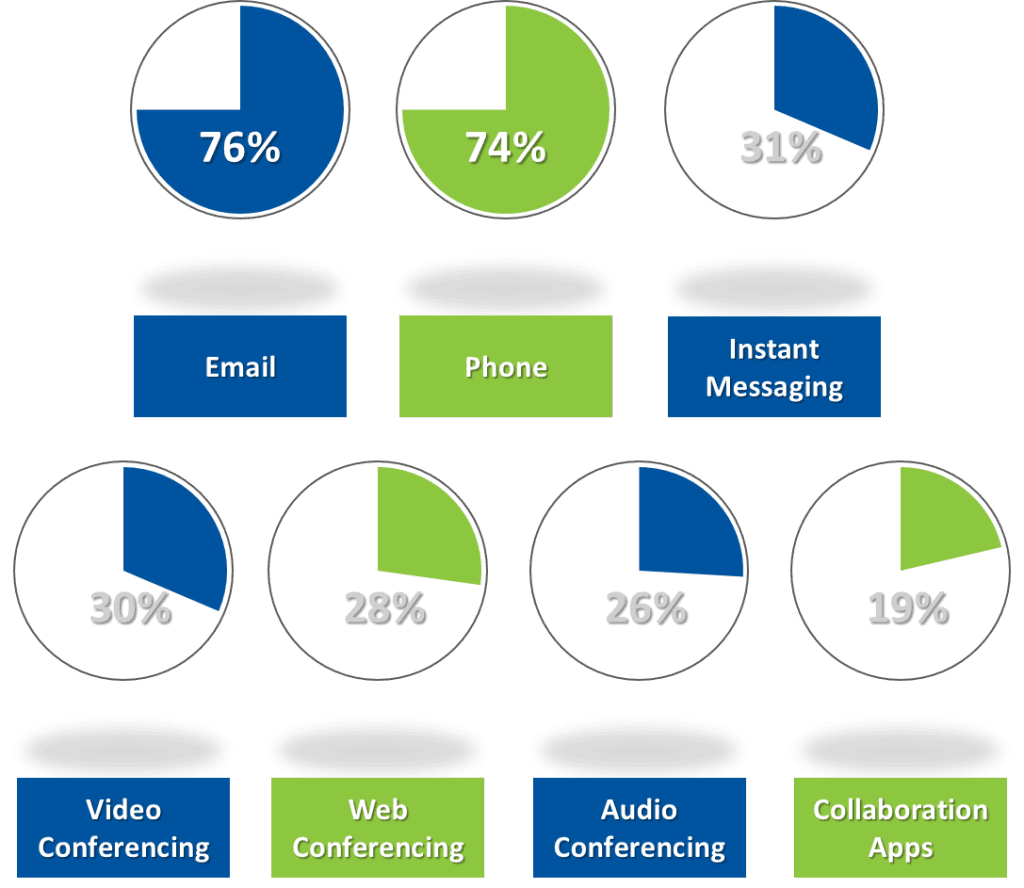The Importance of Phone Communication Systems in the Remote Worker Age

How to Ensure Productivity and Positive Culture Through the Use of Communications Systems
Thirty years ago, the concept that millions of workers nation-wide would work remotely was farfetched. But, with leaps and bounds in the technology sector, workers and companies alike have found increased flexibility, allowing many workers to spend at least some time working remotely. In fact, in 2017, it was reported that 43% of employed Americans said they spent at least some time working remotely. When a group of hiring managers was interviewed, it was found that 38% of hiring managers predicted that their employees will work predominately remotely in the next ten years.
If your company has remote employees or will be increasing telework in the coming years, it’s important that you begin creating a foundation of success today. This foundation can be built on communication and positive culture.
Building a Foundation of Communication
When many people consider communication in the workplace, they are often referring to how well they communicate from one individual to another. And while that is a key factor, when preparing for a remote workforce it’s also important to consider the literal foundation of communication in a business. How will your remote employees communicate with each other if they aren’t able to speak face to face or pop into someone’s office? To guarantee that your remote policy thrives, you need to provide a host of tools for employees to use.
Some employers may think “we have phone and email, isn’t that enough?” Unfortunately, the answer is no. Studies show that every individual uses different methods of communication, based on situational circumstances and individual needs.
The most popular communication methods are as follows:

Given that many people use communication mediums outside of email and phone, it’s vital that your employees have access to a variety of forms of communication.
Guaranteeing Productivity through Communications
With every employee handling a variety of projects, and increased distractions in the workplace, it can be difficult for any employee to stay productive. If you add in having employees working from multiple locations and communication roadblocks, that productivity gets even harder. Empower your employees to stay productive by providing them with a multitude of ways to communicate.
While phone and email are the most popular modes of communication, there are times when other tools can be better used. For instance, if a remote employee has a quick question about a project, it may be better for them to use chat or instant messaging as opposed to sucking up time with a phone call. Or, if your team requires collaboration on a project, instead of spending time calling between individuals, or seeking out a common work space, an audio conference might be best. By providing your employees with a complete communications toolset, you will ensure that they have a solution for every circumstance. This will allow them collaborate and produce, without wasting time hunting each other down or finding a method to get in touch.
Building Positive Remote Workforce Culture
One of the hardest things to foster with remote employees is a positive work culture. Because culture is about how employees work and engage with each other, it’s important to set the stage for a positive culture early on. By providing employees at all locations with a multitude of ways to get in touch with each other, you’re encouraging them to communicate, collaborate, and build relationships, outside of just a couple words in an email. This will allow for your company culture to develop its own connections, jokes, and shared experiences, all lending to the success of your company and increased tenure of your remote employees. Many tools allow for collaboration and fun amongst remote employees.
Instant messaging or chat provides many benefits to your company culture. First and foremost, it provides a way for employees to quickly and easily get in touch with their colleagues. This means that if they have a simple question they aren’t wasting anyone’s time with a phone call. It also means that if they run into a problem, have a question, or need approval on something, they don’t need to suck up extra work time or put customers on hold while they get help. Chats are even recorded, allowing employees to search back through conversations to refer to solutions created in the past and project plans that were discussed. In regards to positive culture, chat allows employees to stay in contact, share jokes, post gifs, and more, creating a place for a culture that is otherwise difficult to develop for remote workers.
Video conferencing allows for high-quality interactions between colleagues even when they aren’t in the same location. How? Studies have shown that 80% of communication is based on visual cues. Video conferencing ensures that no matter where your employees are, they will be able to see each other while they speak, reducing the possibility of misunderstandings. In terms of positive culture, your employees will be able to put faces and individual expressions to names, increasing their engagement and bond with their colleagues. If only some of your employees are remote workers, video conferencing helps integrate them more easily into a group. By being able to video conference an employee in, they are able to virtually attend a meeting, increasing their interaction and the team’s productivity.
Web conferencing allows remote employees to collaborate on and review projects as if they’re in the same conference room. By being able to share documents and screens, remote employees are able to demonstrate what they’re working on as well as receive feedback on live documents. This increases productivity and efficiency in meetings, no matter where your employees are. Instead of waiting for meeting attendees to get on the same page in a document, or open files, web conferencing allows one individual to show exactly what is being reviewed. Even better, web conferences can be recorded and referred back to in the future. In regards to positive culture, web conferencing increases engagement for remote employees, helping them to interact in a meeting and follow along with presentations and spreadsheets.
Unified Communications
While each of these communications systems can be purchased ad hoc, there are benefits to purchasing them as part of a Unified Communications (UC) package. By providing your employees with one communications toolset, you are decreasing the amount of training time they will have to receive. Instead of being trained on and learning each communications tool, they will only require training on a single platform, which will provide consistent navigation, look, and feel. In addition, users will only have to navigate to one location to use their communications tools, refer back to conversations, and access recordings, further increasing their productivity.
Preparing your Communications Foundation
Are you ready to get started with implementing chat, video, and web conferencing for your current or future remote workers? Do you already have these functions but want to increase your communications package to include UC? Don’t hesitate to reach out to Vertical to find out at 877-837-8422. If you don’t have chat, video, web conferencing, or UC as part of your communications solution, Vertical Communications can help you determine the best provider for your needs. Vertical works with our customers to review their needs, issues, and spends, providing recommendations in all areas. This three pronged approach ensures that our customers always receive the right tool for their needs and that it is tailored to their specific business model.



